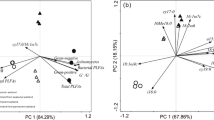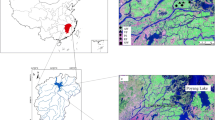Abstract
In this study, we employed pyrosequencing-based analysis of the V4-V6 16S rRNA gene region and community level physiological profiling (CLPP) to characterize and compare bacterial community composition and metabolic activities in order to determine if microbial composition and activity were able to recover in land transitioning from agriculture to natural wetland. The sample sites included natural wetland (with native vegetation), reclaimed for tillage (agriculture), and abandoned tilled (wetland restoration) soils. The entire data set comprised 78,790 good-quality sequences, 62,364 of which were classified in 23 known phyla. The dominant taxonomic groups presented in all samples were Proteobacteria (34.3%), Acidobacteria (15.5%), Verrucomicrobia (6.9%), Chloroflexi (6.3%), Nitrospira (2.6%) and Actinobacteria (2.4%), while 27.1% of the sequences could not be classified to any known phylum. Microbial community composition and activity were found to cluster into two distinct groupings: one associated with agriculture and the other with restored and natural wetlands. The average well colour development (AWCD) based on carbon source utilization pattern was significantly higher in natural and restored wetland soils than in reclaimed soils, suggesting an improvement of soil health. In conclusion, these findings indicated that microbial community composition and activity were affected by land use and may be used to assess the extent of recovery of natural microbial-driven processes during wetland restoration. Furthermore, restored soil microbial communities in this study appear to be tended to a gradual return to those of natural wetland soils with time.





Similar content being viewed by others
References
Acosta-Martínez V, Dowd S, Sun Y, Allen V (2008) Tag-encoded pyrosequencing analysis of bacterial diversity in a single soil type as affected by management and land use. Soil Biology and Biochemistry 40:2762–2770
Alewell C, Paul S, Lischeid G, Storck FR (2008) Co-regulation of redox processes in freshwater wetlands as a function of organic matter availability? The Science of the Total Environment 404:335–342
Andersen R, Grasset L, Thormann MN, Rochefort L, Francez AJ (2010) Changes in microbial community structure and function following Sphagnum peatland restoration. Soil Biology and Biochemistry 42:291–301
Becker J, Eisenhauer N, Scheu S, Jousset A (2012) Increasing antagonistic interactions cause bacterial communities to collapse at high diversity. Ecology Letters 15:468–474
Bending GD, Turner MK, Jones JE (2002) Interactions between crop residue and soil organic matter quality and the functional diversity of soil microbial communities. Soil Biology and Biochemistry 34:1073–1082
Bisset A, Richardson A, Baker G, Thrall PH (2011) Long-term land use effects on soil microbial community structure and function. Applied Soil Ecology 51:66–78
Blake GR (1965) Bulk density. Methods of soil analysis. Part 1. Physical and mineralogical properties, Including statistics of measurement and sampling, 374–390
Bouyoucos GJ (1962) Hydrometer method improved for making particle size analysis of soils. Agronomy Journal 56:464–465
Campbell BJ, Polson SW, Hanson TE, Mack MC, Schuur EA (2010) The effect of nutrient deposition on bacterial communities in Arctic tundra soil. Environmental Microbiology 12:1842–1854
Carbonetto B, Rascovan N, Álvarez R, Mentaberry A, Vázquez MP (2014) Structure, composition and metagenomic profile of soil microbiomes associated to agricultural land use and tillage systems in Argentine Pampas. PLoS One 9(6):e99949
Castro HF, Classen AT, Austin EE, Norby RJ, Schadt CW (2010) Soil microbial community responses to multiple experimental climate change drivers. Applied and Environmental Microbiology 76:999–1007
Chaudhry V, Rehman A, Mishra A, Chauhan PS, Nautiyal CS (2012) Changes in bacterial community structure of agricultural land due to long-term organic and chemical amendments. Microbial Ecology 64:450–460
Cole JR, Chai B, Farris RJ, Wang Q, Kulam SA, McGarrell DM, Garrity GM, Tiedje JM (2004) The ribosomal database project (RDP-II): sequences and tools for high- throughput rRNA analysis. Nucleic Acids Research 33:294–296
DeAngelis KM, Silver WL, Thompson AW, Firestone MK (2010) Microbial communities acclimate to recurring changes in soil redox potential status. Environmental Microbiology 12(12):3137–3149
Ding GC, Piceno YM, Heuer H, Weinert N, Dohrmann AB, Carrillo A, Andersen GL, Castellanos T, Tebbe CC, Smalla K (2013) Changes of soil bacterial diversity as a consequence of agricultural land use in a semi-arid ecosystem. PLoS One 8(3):e59497
Doi R, Ranamukhaarachchi SL (2013) Slow restoration of soil microbial functions in an Acacia plantation established on degraded land in Thailand. International Journal of Environmental Science and Technology 10:623–634
Dominati E, Patterson M, Mackay A (2010) A framework for classifying and quantifying the natural capital and ecosystem services of soils. Ecology Economics 69:1858–1868
Drenovsky RE, Steenwerth KL, Jackson LE, Scow KM (2010) Land use and climatic factors structure regional patterns in soil microbial communities. Global Ecology and Biogeography 19:27–39
Fierer N, Jackson RB (2006) The diversity and biogeography of soil bacterial communities. Proceedings of the National Academy of Sciences of the United States of America 103:626–631
Fierer N, Leff JW, Adams BJ, Nielsen UN, Bates ST, Lauber CL, Owens S, Gilbert JA, Wall DH, Caporaso JG (2012) Cross-biome metagenomic analyses of soil microbial communities and their functional attributes. Proceedings of the National Academy of Sciences of the United States of America 109:21390–21395
Fierer N, Ladau J, Clemente JC, Leff JW, Owens SM, Pollard KS, Knight R, Gilbert JA, Gilbert JA (2013) Reconstructing the microbial diversity and function of pre-agricultural tallgrass prairie soils in the United States. Science 342:621–624
Garland JL, Mills AL (1991) Classification and characterization of heterotrophic microbial communities on the basis of patterns of community level sole carbon source utilization. Applied and Environmental Microbiology 57:2351–2359
Girvan MS, Bullimore J, Pretty JN, Osborn AM, Ball AS (2003) Soil type is the primary determinant of the composition of the total and active bacterial communities in arable soils. Applied and Environmental Microbiology 69:1800–1809
Gotelli N, Colwell RK (2001) Quantifying biodiversity: procedures and pitfalls in the measurement and comparison of species richness. Ecology Letters 4:379–391
Guan X, Wang J, Zhao H, Wang JJ, Luo X, Liu F, Zhao F (2013) Soil bacterial communities shaped by geochemical factors and land use in a less-explored area, Tibetan Plateau. BMC Genomics 14:820–833
Harris JA (2003) Measurements of the soil microbial community for estimating the success of restoration. European Journal of Soil Science 54:801–808
Hartman WH, Richardson CJ, Vilgaly R, Bruland GL (2008) Environmental and anthropogenic controls over bacterial communities in wetland soils. Proceedings of the National Academy of Sciences of the United States of America 105:17842–17847
Jousset A, Schmid B, Scheu S, Eisenhauer N (2011) Genotypic richness and dissimilarity opposingly affect ecosystem functioning. Ecology Letters 14:537–545
Kubler LA, Miller JO, Ducey TF, Hunt PG, Lang M, Ro KS (2014) Multistate assessment of wetland restoration on CO2 and N2O emissions and soil bacterial communities. Applied Soil Ecology 76:87–94
Legendre P, Legendre L (1998) Numerical Ecology, 2nd English edn, pp. 853. Elsevier, New York
Lewis DE, White JR, Wafula D, Athar R, Dickerson T, Williams HN, Chauhan A (2010) Soil functional diversity analysis of a bauxite-mined restoration chronosequence. Microbial Ecology 59:710–723
Li JH, Jiao SM, Gao RQ, Bardgett RD (2012) Differential effects of legume species on the recovery of soil microbial communities, and carbon and nitrogen contents, in abandoned fields of the loess plateau, China. Environmental Management 50:1193–1203
Lu RK (2000) Methods of soil and agricultural chemistry analysis. Chinese agricultural science and technology Press, Beijing, 1–627
Lu XX, Sun SL, Zhang YQ, Hollibaugh JT, Mou XZ (2015) Temporal and vertical distribution of bacterioplankton at the G ray’s reef national marine sanctuary. Applied and Environmental Microbiology 83(23):910–917
Min Q (1999) Evaluation of the effects of expanding agricultural land use on floods in the Poyang Lake. People Yangtze River 30:30–32
Mitsch WJ, Gosselink JG (2007) Wetlands, fourthed. Wiley, New York
Nacke H, Thürmer A, Wollherr A, Will C, Hodac L, Herold N, Schöning I, Schrumpf M, Daniel R (2011) Pyrosequencing-based assessment of bacterial community structure along different management types in German forest and grassland soils. PLoS One 6:e17000
Nautiyal CS, Chauhan PS, Bhatia CR (2010) Changes in soil physico-chemical properties and microbial functional diversity due to 14 years of conversion of grassland to organic agriculture in semi-arid agroecosystem. Soil & Tillage Research 109:55–60
Quince C, Lanzén A, Curtis T, Davenport R, Hall N, Head LM, Read LF, Sloan WT (2009) Accurate determination of microbial diversity from 454 pyrosequencing data. Nature Methods 6(9):639–644
Rampelotto PH, Ferrira A, Barboza ADM, Roesch LFW (2013) Changes in diversity, abundance, and structure of soil bacterial communities in Brazilian Savanna under different land use systems. Microbial Ecology 66:593–607
Richardson CJ, Marshall PE (1986) Processes controlling the movement, storage, and export of phosphorus in a fen peatland. Ecology Monographs 56:279–302
Roulet NT (2000) Peatlands, carbon storage, greenhouse gases and the Kyoto protocol: prospects and significance for Canada. Wetlands 20:605–615
Schloss PD, Handelsman J (2004) Status of the microbial census. Microbiology and Molecular Biology Reviews 68:686–691
Schloss PD, Westcott SL, Ryabin T (2009) Introducing mothur: open source, platform-independent, community-supported software for describing and comparing microbial communities. Applied and Environmental Microbiology 75:7537–7541
Sharma S, Rangger A, von Lützow M, Insam H (1998) Functional diversity of soil bacterial communities increases after maize litter amendment. European Journal of Soil Biology 34:53–60
Sheng R, Meng D, Wu M, Di H, Qin HL, Wei W (2013) Effect of agricultural land use change on community composition of bacteria and ammonia oxidizers. Journal of Soils and Sediments 13:1246–1256
Swift MJ, Heal OW, Anderson JM (1979) Decomposition in terrestrial ecosystems. Blackwell Scientific Publications, Oxford
Tsitko I, Lusa M, Lehto J, Parviainen L, Ikonen AT, Lahdenperä AM, Bomberg M (2014) The variation of microbial communities in a depth profile of an acidic, nutrient-poor boreal bog in southwestern Finland. Open Journal of Ecology 4:832–859
Turner S, Pryer KM, Miao VP, Palmer JD (1999) Investigating deep phylogenetic relationships among cyanobacteria and plastids by small subunit rRNA sequence analysis. Journal of Eukaryotic Microbiology 46:327–338
US Environmental Protection Agency (2014) Soil sampling operation procedures
van Dijk J, Didden WA, Kuenen F, van Bodegom PM, Verhoef HA, Aerts R (2009) Can differences in soil community composition after peat meadow restoration lead to different decomposition and mineralization rates? Soil Biology and Biochemistry 41:1717–1725
Wang Q, Garrity GM, Tiedje JM, Cole JR (2007) Naive Bayesian classifier for rapid assignment of rRNA sequences into the new bacterial taxonomy. Applied and Environmental Microbiology 73:5261–5267
World Conservation Union (1996) Guidelines for aid agencies for improved conservation and sustainable use of tropical and sub-tropical wetlands. Organization for Economic Cooperation and Development, Paris
Yu WT, Bi ML, Xu YG, Zhou H, Ma Q, Jiang CM (2013) Microbial biomass and community composition in a Luvisol soil as influenced by long-term land use and fertilization. Catena 107:89–95
Zak DR, Holmes WE, White DC, Peacock AD, Tilman D (2003) Plant diversity, soil microbial communities, and ecosystem function: are there any links? Ecology 84:2042–2050
Zhang T, Shao MF, Ye L (2012) 454 pyrosequencing reveals bacterial diversity of activated sludge from 14 sewage treatment plants. The ISME Journal 6:1137–1147
Zhao D, Li F, Yang Q, Wang R, Song Y, Tao Y (2013) The influence of different types of urban land use on soil microbial biomass and functional diversity in Beijing, China. Soil Use and Management 29:230–239
Acknowledgements
This research was supported by the National Natural Science Foundations of China (Grant No. 31360127, 30860062 and 31660149) and the Open Foundation of MOE Key Laboratory of Poyang Lake Environment and Resource (PYH2015-13) and Nanchang University Seed Grant for Biomedicine (9202-0210210807). We appreciate Dr. Rong J and Lan ZC for invaluable comments on early drafts of this paper, and we also thank two anonymous reviewers for providing comments that helped us improve this paper.
Author information
Authors and Affiliations
Corresponding authors
Rights and permissions
About this article
Cite this article
Huang, L.L., Kou, W.B., Wu, L. et al. Microbial Composition and Activity of Natural, Restored, and Reclaimed Wetland Soils: a Case Study of Poyang Lake Basin, China. Wetlands 39 (Suppl 1), 113–123 (2019). https://doi.org/10.1007/s13157-018-1020-y
Received:
Accepted:
Published:
Issue Date:
DOI: https://doi.org/10.1007/s13157-018-1020-y




